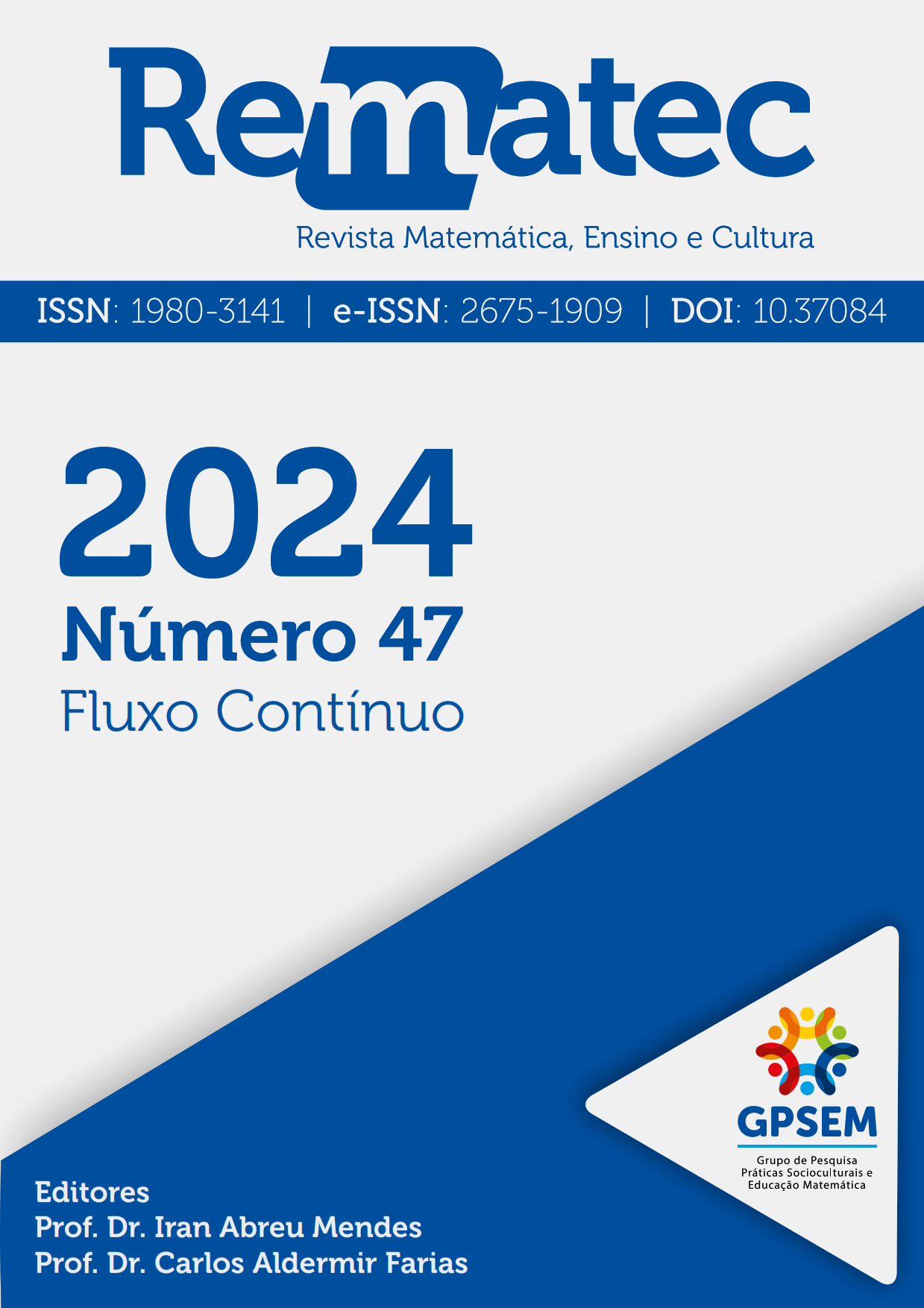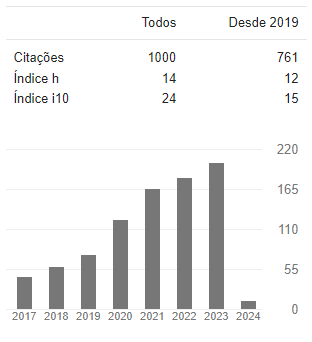Binary Numeration: From Ancient Egypt to a 19th Century French Mathematical Recreation
DOI:
10.37084/REMATEC.1980-3141.2024.n47.e2024005.id607Palavras-chave:
History of Mathematics, Mathematical Recreations, Mathematics Education, Binary system, NumbersResumo
This article focuses on the use of base 2 in two historical contexts: ancient Egypt during the Middle Kingdom and 19th-century France. In ancient Egypt, base 2 was central to the “duplation” algorithm to multiply two numbers. In 19th-century France, it featured in mathematical recreations by Charles-Ange Laisant and Édouard Lucas. Duplation in ancient Egypt involved doubling a number successively, leveraging the binary nature of the numbering system for rapid calculations. In France, Laisant and Lucas contributed to mathematical recreations rooted in base 2, popularizing mathematics and engaging the public. The article aims to present these historical resources, highlighting their educational potential. It suggests integrating these examples into mandatory education from age 9 onwards, offering students a practical understanding of mathematics and its history. However, specific teaching methods are left to the reader’s discretion.
Downloads
Métricas
Referências
AUVINET, J. Charles-Ange Laisant. Itinéraires et engagements d’un mathématicien de la Troisième République. Paris: Hermann, 2013.
AUVINET, J. Charles-Ange Laisant, un acteur pour les mathématiques discrètes et leur communauté à la fin du XIXe siècle. In : BARBIN, É.; GOLDSTEIN C.; MOYON M.; SCHWER S.; VINATIER S. (Org.) Les travaux combinatoires en France (1870-1914) et leur actualité : Un hommage à Henri Delannoy. Limoges : Presses universitaires de Limoges, 2017.
BARBIN É. ; GOLDSTEIN C. ; MOYON M. ; SCHWER S. ; VINATIER S. (Org.) Les travaux combinatoires en France (1870-1914) et leur actualité : Un hommage à Henri Delannoy. Limoges: Presses universitaires de Limoges, 2017.
BOUCARD, J. Eugène Charles Catalan et la théorie des nombres, Bulletin de la société des amis du musée, de la bibliothèque et de l’histoire de l’école polytechnique, v. 57, p. 49-56, 2015. https://doi.org/10.4000/sabix.1959 DOI: https://doi.org/10.4000/sabix.1959
CAVEING, M. Essai sur le savoir mathématique dans la Mésopotamie et l’Égypte anciennes, Villeneuve d’ascq: Presses Universitaires de Lille, 1994.
CHORLAY, R.; CLARK, K. M.; TZANAKIS C. History of mathematics in mathematics education: Recent developments in the field. ZDM – Mathematics Education, v. 7, n. 54, p. 1407-1420, 2022. https://doi.org/10.1007/s11858-022-01442-7 DOI: https://doi.org/10.1007/s11858-022-01442-7
DÉCAILLOT, A.-M. L’arithméticien Édouard Lucas (1842-1891) : théorie et instrumentation, Revue d’histoire des mathématiques, v. 4, p. 191-236, 1998. Available on http://www.numdam.org/item/RHM_1998__4_2_191_0/
DECAILLOT, A.-M. (1999). Édouard Lucas (1842–1891): le parcours original d'un scientifique français dans la deuxième moitié du XIXe siècle. PhD in history of mathematics, Université Paris Descartes, 1999. Available on http://tony.reix.free.fr/EdouardLucas/LUCAS_BOOK_THESE.PDF
DECAILLOT, A.-M. Les Récréations Mathématiques d’Édouard Lucas : quelques éclairages, Historia Mathematica, v. 41, n. 4, p. 506-517, 2014. https://doi.org/10.1016/j.hm.2014.05.005 DOI: https://doi.org/10.1016/j.hm.2014.05.005
EHRHARDT, C. A locus for transnational exchanges : European mathematical journals for students and teachers, 1860s–1914, Historia Mathematica, v. 45, n. 4, p. 376–394, 2018. https://doi.org/10.1016/j.hm.2018.10.004 DOI: https://doi.org/10.1016/j.hm.2018.10.004
FAUVEL, J. ; VAN MAANEN, J. History in mathematics education : the ICMI study, Dordrecht: Kluwer, 2000. https://doi.org/10.1007/0-306-47220-1 DOI: https://doi.org/10.1007/0-306-47220-1
GAEL, N. Jogos científicos, França, p. 3, 2 de dezembro de 1889.
GOLDSTEIN, C. « S’occuper des mathématiques sans y être obligé » : pratiques professionnelles des mathématiciens amateurs en France au XIXe siècle, Romantisme, v. 4, n. 190, p. 52-63, 2020. https://doi.org/10.3917/rom.190.0052 DOI: https://doi.org/10.3917/rom.190.0052
IMHAUSEN, A. Ägyptische Algorithmen : eine Untersuchung zu den mittelägyptischen mathematischen Aufgabentexten. Wiesbaden: Harrassowitz Verlag, 2003.
IMHAUSEN, A. Mathematics in Ancient Egypt : a contextual history, Princeton: Princeton University Press, 2016. DOI: https://doi.org/10.23943/princeton/9780691117133.001.0001
JANKVIST, U. T. A categorization of the “whys” and “hows” of using history in mathematics education, Educational Studies in Mathematics, v. 3, n. 71, p. 235-261, 2009a.
https://doi.org/10.1007/s10649-008-9174-9 DOI: https://doi.org/10.1007/s10649-008-9174-9
JANKVIST, U. T. Using history as a “goal” in mathematics education, PhD in Roskilde University, 2009b. Available on http://thiele.ruc.dk/imfufatekster/pdf/464.pdf.
KATZ, V. J.; MICHALOWICZ, K. D. (Org.) Historical modules for the teaching and learning of mathematics. Washington, DC: The Mathematical Association of America, 2004. DOI: https://doi.org/10.1090/clrm/026
LAISANT, C.-A. Initiation mathématique : ouvrage étranger à tout programme, dédié aux amis de l’enfance. (2e édition) Paris: Hachette & Cie, 1907.
LAISANT, C.-A. Initiation mathématique : ouvrage étranger à tout programme, dédié aux amis de l’enfance. Paris : Hachette & Cie, 1915.
LAISANT, C.-A. Iniciação Matematica, trad. Henrique Schindler, (2e éd.), Lisboa, Guimarães & Ca, 1919.
LAISANT, C.-A. L’enseignement du Calcul. Conseils aux instituteurs. Paris : Librairie Hachette, 1920.
LUCAS, É. Théorie des nombres. Tome premier. Paris : Gauthier-Villars et fils, 1891a.
LUCAS, É. Récréations mathématiques. Paris : Gauthier-Villars et fils, 1891b.
LUCAS, É. L’arithmétique amusante. Amusements scientifiques pour l'enseignement et la pratique du calcul. Paris : Gauthier-Villars et fils, 1895.
MICHEL, M. Les mathématiques de l’Égypte ancienne : numération, métrologie, arithmétique, géométrie et autres problèmes. Bruxelles: Éditions Safran, 2014.
MOYON, M. S’initier à “la mathématique” avec Charles-Ange Laisant : manipuler, visualiser, s’étonner, Bulletin de la société des amis du musée, de la bibliothèque et de l’histoire de l’école polytechnique, v. 70, p. 131-143, 2023a. https://doi.org/10.4000/sabix.3328 DOI: https://doi.org/10.4000/sabix.3328
MOYON, M. Fractions égyptiennes et algorithme de Fibonacci : histoire des mathématiques versus manuels scolaires contemporains. ACERVO - Boletim do Centro de Documentação do GHEMAT-SP, v. 5, p. 1-36, 2023b. https://doi.org/10.55928/ACERVO.2675-2646.2023.5.88 DOI: https://doi.org/10.55928/ACERVO.2675-2646.2023.5.88
MOYON, M. La dimension internationale de l’Initiation mathématique de C.-A. Laisant : sa traduction italienne à partir de deux lettres reçues par Laisant, Images des mathématiques, 2023c. Available on https://images.math.cnrs.fr/La-dimension-internationale-de-l-Initiation-mathematique-de-C-A-Laisant-1906.html
MOYON, M. Nombres, opérations et problèmes récréatifs : histoire(s) parfaite(s) et figurée(s) pour enseigner l’arithmétique en cycle 3. In : Raisonner en arithmétique. Est-ce incongru ? Actes du colloque inter-IREM collège et lycée, Bordeaux (juin 2024), Bordeaux, 2024
RITTER, J. Egyptian Mathematics. In Selin, H. (dir.), Encyclopaedia of the History of Science, Technology, and Medicine in Non-Western Cultures. Berlin, Heidelberg, New York : Springer, p. 1378-1381, 2008. DOI: https://doi.org/10.1007/978-1-4020-4425-0_8739
ROUGETET, L. Le binaire au bout des doigts : Un casse-tête entre récréation mathématique et enseignement. Les Ullis: EDP sciences, 2023. DOI: https://doi.org/10.1051/978-2-7598-3088-6
SERRA, Y. Le manuscrit « De Progressione Dyadica » de Leibniz, Bibnum. Textes fondateurs de la science, 2010. https://doi.org/10.4000/bibnum.553 DOI: https://doi.org/10.4000/bibnum.553
SILVA DA SILVA, C. M. ; LEME DA SILVA, M. C. La diffusion des idées pédagogiques de Laisant au Brésil, Bulletin de la société des amis du musée, de la bibliothèque et de l’histoire de l’école polytechnique, v. 70, p. 144-152, 2023. https://doi.org/10.4000/sabix.3336 DOI: https://doi.org/10.4000/sabix.3336
STRICKLAND, L. Two Lost Operations of Arithmetic: Duplation and Mediation. Mathematics Today, v. 58, n. 6, p. 196-197, 2022.
Downloads
Publicado
- Visualizações do Artigo 255
- PDF downloads: 57







 Português (Brasil)
Português (Brasil)
 Español (España)
Español (España)
 English
English































































